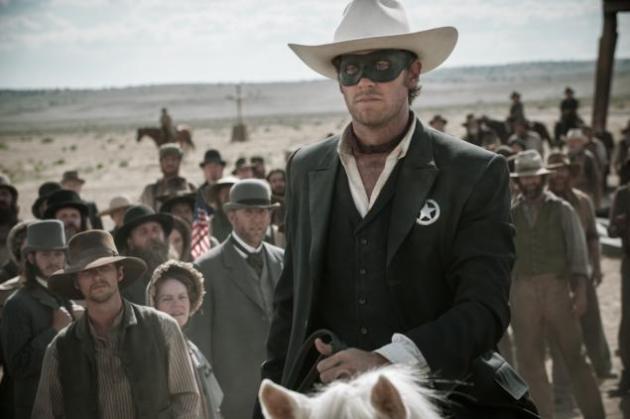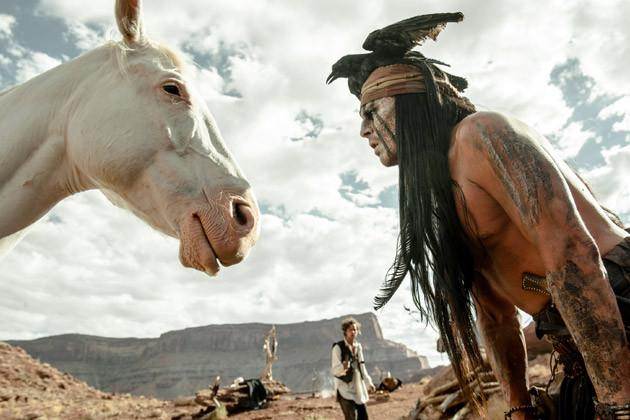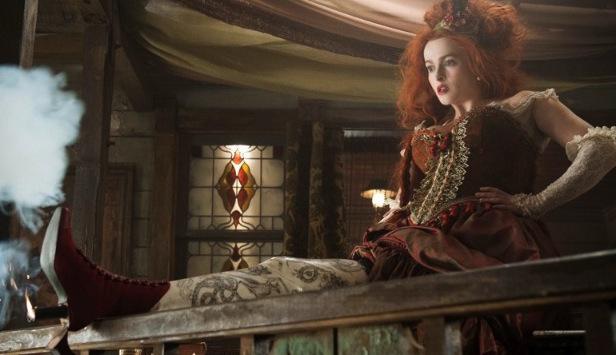When you have a Armie Hammer, everything looks like a nail.
That sentence has nothing to do with the movie itself, but I guess The Lone Ranger itself doesn’t have anything to do with The Lone Ranger of the past. Yes, the inevitable mining of intellectual properties by Hollywood has led to them resurrecting The Lone Ranger himself into a modern day blockbuster filled with Johnny Depp, action, Johnny Depp, more extraneous action and did I mention, Johnny Depp. The Hollywood juggernauts behind the Pirates series decide that the American Western needs more Jack Sparrow and ridiculous run times to the proceedings to make it palpable for the current film going public. Let me just say this right off the bat, this cowboy should have rode off into the sunset, never to be seen again.

Gore Verbinski, the director behind the Pirates of the Caribbean series, brings his “more action, less everything” approach to the remake/reboot/whatever of the 1933 WXYZ radio station creation. The modern update to the masked cowboy sees Johnny Depp in the main role as the Lone Ranger/John Reid….I mean he plays Tonto, with Armie Hammer as the secondary character John Reid/Lone Ranger. Tonto tells the tale of the hero known as The Lone Ranger to a young boy, which is a narrative that is not needed other than to give Depp the ability to wear old man makeup and breakup the pace of a movie that is running almost two and a half hours. The story is about Tonto and his sidekick John Reid as they battle not one, but three villains in this movie and trying to save the Native Americans or something. I don’t honestly know where the script is going here since the movie shifts tone and sub plots like nobodies business. All I know is that there is action, some suspense and a lot of stuff that could have been cut.
So here’s the good and the bad of The Lone Ranger:
Good Thing: Johnny Depp is cast in the movie!
Bad Thing: You specifically cast Johnny Depp as sidekick/lead of the movie.
In reality, this movie should have been just called Tonto cause the focus of the movie seems to be from the point of view of Tonto and all about how Tonto is some metaphor to right the wrongs of the portrayal of Native Americans in westerns and in cinema. I won’t comment on the whole, “should Depp even play a Native American when he isn’t or is Native American” thing cause it doesn’t really matter here. Depp does more to insult the portrayal of Native Americans here by having the film base his look off of a painting by Kirby Sattler who painted an image of a mystical Native American, a common stereotype for Native Americans. With that image firmly in place, Depp proceeds to even speak in this atrocious broken English, furthering playing up stereotypes of Native Americans in cinema. Whatever, this is all just complaints of a larger argument as Depp just plays Tonto like a Jack Sparrow offshoot and never really adding anything new to the sidekick role. The focus of the movie is squarely on him, but it doesn’t go anywhere or develop anything.
Good Thing: Armie Hammer gets his time to shine as a lead.
Bad Thing: Armie Hammer plays a sidekick in The Lone Ranger.
What a terrible thing to take The Lone Ranger and make him an ancillary character. Hammer has the waspy, square jawed look of the masked hero and has the particular bravado to make a compelling John Reid, but his character isn’t given the opportunity to feel defined or chiseled in our minds. It’s sad really when you see how well Hammer and Depp interact with one another, but their relationship only shines when the abrupt, comedic bumps of the film come and go. There isn’t a moment where the Lone Ranger has an opportunity to grow for the audience, instead we are treated to the retelling of the character and his journey by an aging Tonto.

Good Thing: Great cast of villains and secondary characters.
Bad Thing: Why so many villains and secondary characters?
Within the narrative of The Lone Ranger is a plot line involving three villains. The main villain is Butch Cavendish played by William Fitchner, a ruthless outlaw who is a formidable opponent by himself, Fitchner definitely adds something diabolic to a character who is more or less responsible for the main plot line and journey of Reid and Tonto. Then you have Barry Pepper as corrupt US Marshall Fuller and Railroad Tycoon Latham Cole played by Tom Wilkinson. All their characters serve to tie down and overload a script that doesn’t have a cohesive tone to the movie which is clear about an hour into the movie. All these fantastic actors are rendered useless and just there to serve a large plot that isn’t necessarily clear to even the filmmakers. Along with the villains of the movies, there are some lady parts in the film, which are merely there in my opinion to not have it be one giant sausage party.
The two female leads are played by Helena Bonham Carter as the madam Red, who the filmmakers made so they can have an excuse to showcase this sweet porcelain, fake leg with a hidden gun in it and Ruth Wilson as Rebecca, Reid’s Sister-in-law. They serve nothing to the overall plot and in all honestly, Carter’s role and scenes could have been excised and not missed at all, especially with the two and a half hour run time. What a stunning cast that is just crammed together to form nothing.
Good Thing: At the center of this movie, beats the heart of a true western.
Bad Thing: The heart goes into arrest due to run time, grandiose action sequences and tone deaf direction.
I can’t fault Verbinski and the Mouse from wanting another Pirates movie. It made them a boat load of cash and the formula for success was there all along. The problem is that the western doesn’t translate well when your tone and direction are all over the place, the action sequences are ridiculous in and of themselves and finally you misuse your hero and sidekick. The template of a great western is there for Verbinski to utilize, the picturesque landscape of the southwest sets the frame of the movie, the endearing hero takes up the mask to protect the innocent and the duo help one another to overcome insurmountable odds. The problem is that the template is just a base that the filmmakers use to pile on ridiculous action sequences in place of developing on the themes present in the movie. On one hand you have two amazing action sequences by themselves, but the use of the heroes makes them seem superhuman in their feats. The sequences are too grandiose, taking the wind out of the common, every man hero that the Ranger is and makes him into a Spiderman like character who leaps from train car to train car. I half expected Superman to show up in the action sequences.
The tone of the movie itself is also one of the biggest problems of the movie. I am not certain what is really the direction that they wanted to go. At times you have this buddy ranger/indian movie with the leads trading smarmy remarks and witty banter, then it goes into deep reflection about the plight of the Native Americans and their current genocide, and then we dive into a dark, supernatural side with a cannibalistic villain. What the hell are we supposed to latch onto? What is the thread that is bringing this all together? I wish the movie would have stuck with the original Werewolves plot line since that would have been the single most unifying theme in the movie. It doesn’t know what it wants to be, so why not try everything I guess. Hell with two and half hours, they got plenty of time to try it all out.

Good Thing: The Lone Ranger presents the hero’s journey of the masked rider.
Bad Thing: The journey is really just white guilt.
I am sorry, but the fact that The Lone Ranger takes up the mask because he is ashamed of what his fellow white men are doing to the land and Native American’s is one of the dumbest and asinine reasons for a guy to become the hero the country needs. Reid realizes how corrupt his fellow white man are and decides he needs to distance himself from them so as not to be lumped in with their killing ways, so his mask is what makes him different. Tonto even explains the need for the mask, “There come a time, when good man must wear mask.” The mask is just this white guilt that Reid wears in order to become the better man or better white man I guess. This is a slap in the face to the true nature of the Lone Ranger, where the hero saw injustice in the land and did what is right. Not just deciding to wear a mask so he won’t get scalped by the red man. Fuck this.
Overall The Lone Ranger is just a huge misstep in understanding what made the original Ranger such an icon within the Western genre. This interpretation is just the regurgitated formula of potential success that Disney and Verbinski thought would work again since Pirates proved fruitful. But shafting the main character to a secondary role and having Johnny Depp do the same thing he always does wears out its welcome real quick. The long running time of this movie is just so daunting because the misguided plot and tone of the movie produces a scatter shot of hit and misses with the audience that they can’t latch on to one central theme. The narrative device of the flashback and forth between the story and Depp telling the story is annoying and kills momentum. The hero’s journey is white guilt and everything that made The Lone Ranger unique and enjoyable, is just another forgettable summer blockbuster.
In closing…
Good Thing: Hey they used The William Tell Overture! which is the main theme for The Lone Ranger.
Bad Thing: Everything else.
Rating: One silver bullet out of five.

